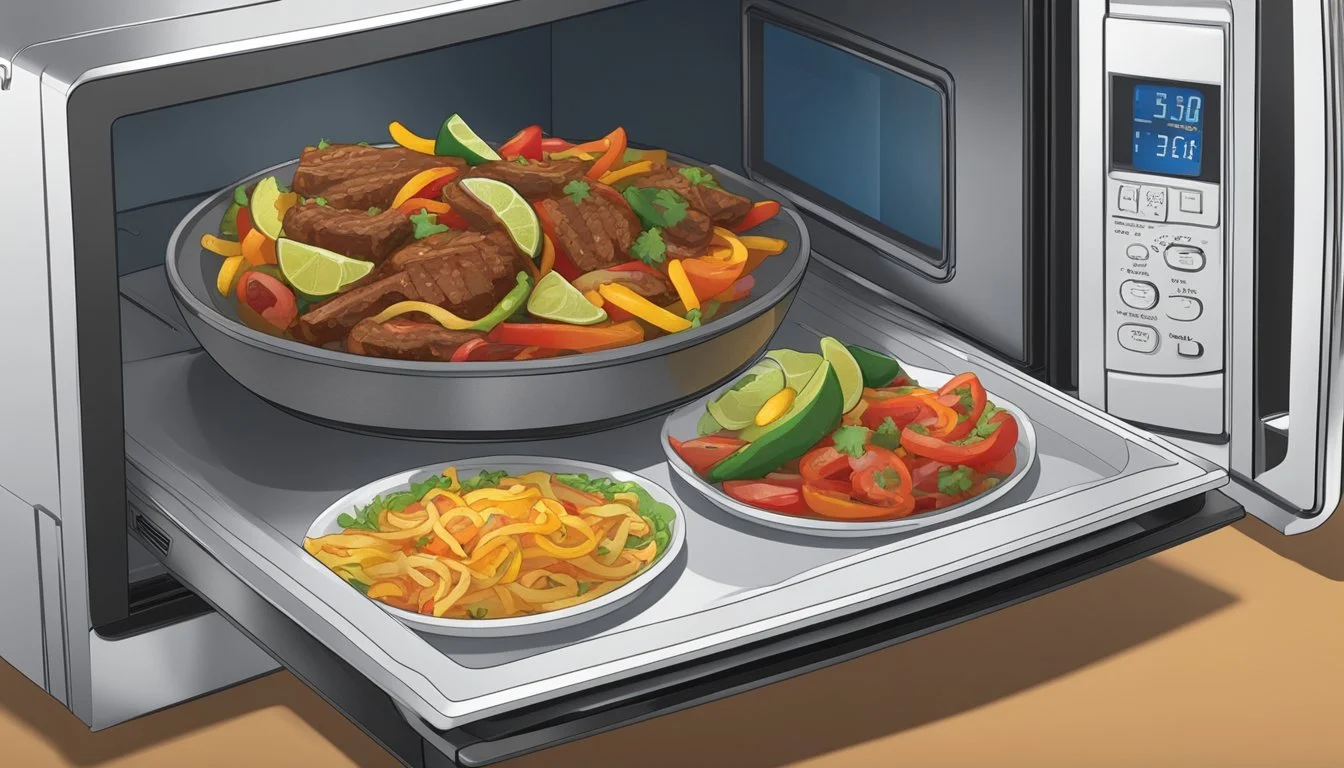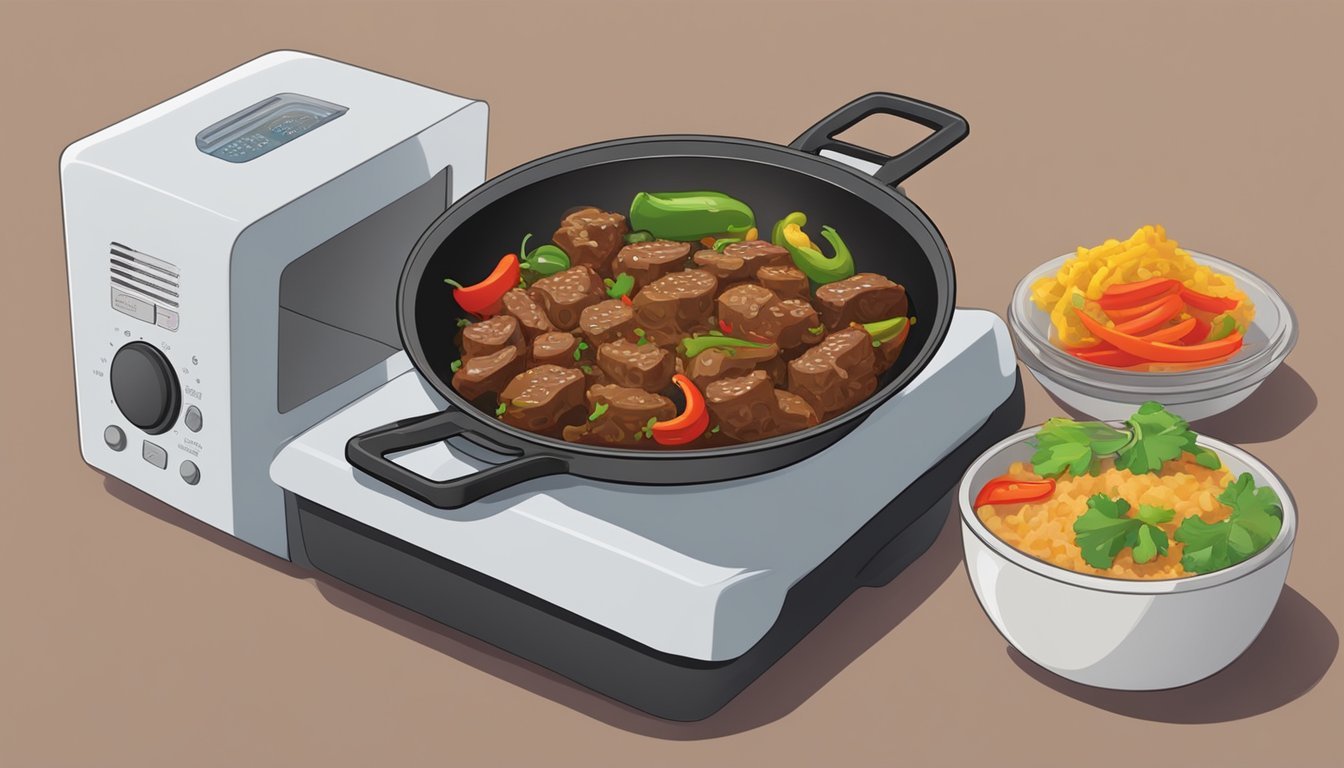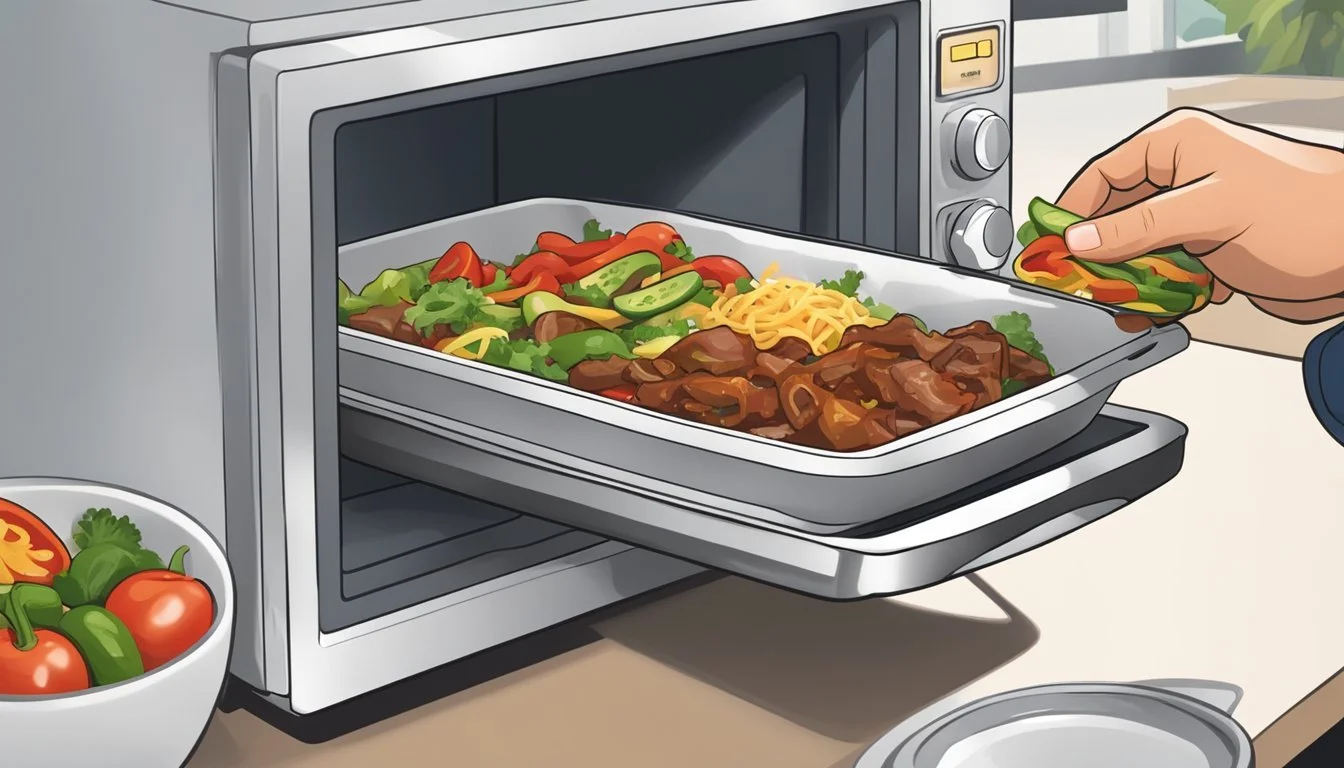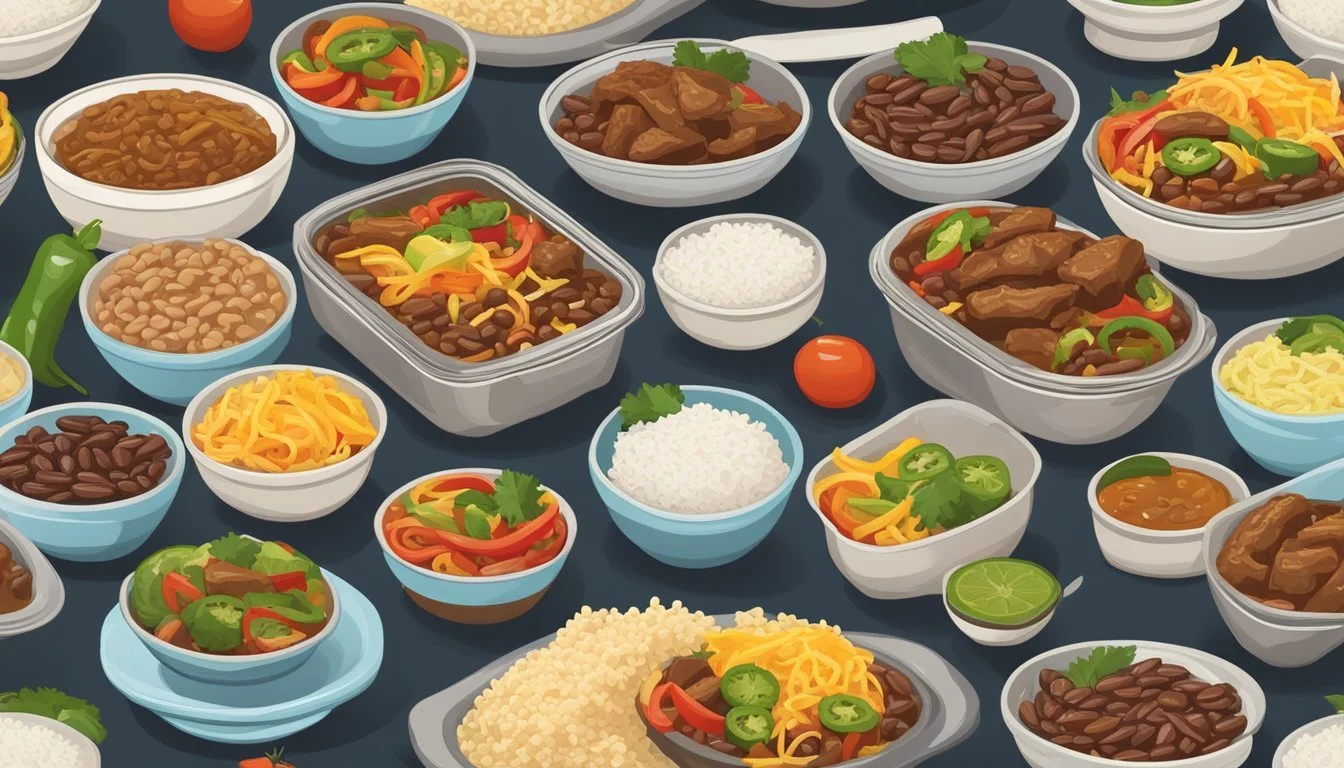How to Reheat Beef Fajita Bowls
Step-by-Step Guide for Perfect Results
Reviving the deliciousness of a beef fajita bowl can be straightforward and satisfying. Whether it's through the oven, stovetop, air fryer, or microwave, ensuring that every bite retains its flavor and texture is key. Using varying techniques can cater to different preferences for convenience and crispiness.
For those who appreciate the nuance of perfectly warmed meat and veggies, preheating an oven to 350°F (175°C) and reheating the fajitas for about 5-7 minutes will provide an even and thorough reheat. If speed is a priority, a microwave with a damp paper towel can quickly bring back the warmth without drying out the meat.
Reheating on a stovetop in a skillet with a bit of oil can revitalize the fajita bowl, adding a slight sear for extra flavor. An air fryer also offers a quick and efficient method, keeping the fajitas crispy. Discover which reheating method suits you best to enjoy those savory beef fajita bowls just as much the second time around.
Understanding the Components of Beef Fajita Bowls
Beef fajitas are the star of the bowl. Typically, they consist of seasoned and grilled beef strips that provide a flavorful base.
Vegetables play a crucial role, adding both flavor and nutrition. Common choices include sliced onions and bell peppers, usually sautéed until tender.
A tortilla is often included on the side, either flour or corn, allowing for wrap options.
Cheese, often shredded cheddar or Monterey Jack, adds a creamy and slightly salty richness.
Salsa provides a zesty and tangy kick. It can be mild, medium, or hot, depending on preference.
Rice is another staple in beef fajita bowls. Spanish rice or cilantro-lime rice are popular options that complement the other ingredients.
Beans, such as black beans or pinto beans, offer a hearty and protein-packed component.
Guacamole adds a smooth and creamy texture. It’s made from mashed avocados, often mixed with lime, salt, and cilantro.
Lettuce offers a fresh and crunchy element. Romaine or iceberg are typical varieties used.
Sour cream adds a cool and tangy contrast to the warm and spicy fajitas.
Tomatoes bring a juicy and slightly sweet component. They are often diced and sprinkled over.
A sprinkle of cilantro adds a fresh, citrusy flavor, enhancing the overall dish.
Finally, lime wedges provide a bright, acidic note. Squeezing fresh lime juice over the bowl brings out all the flavors.
Pre-Reheating Considerations
Effective reheating of beef fajita bowls starts with proper storage and understanding their lifespan in the refrigerator or freezer.
Proper Storage Techniques
Ensuring your beef fajita bowls are stored correctly is crucial for maintaining their flavor and safety. Use airtight containers to prevent contamination and keep out moisture, which can lead to bacterial growth. Place the leftovers in the refrigerator if you plan to consume them within a few days. For longer storage, use a freezer-safe container to protect the food from freezer burn. Label the containers with the date to keep track of their storage time.
Avoid overfilling the containers to allow for expansion during freezing. Make sure to cool the fajitas to room temperature before sealing to prevent condensation inside the container. This keeps the fajitas fresh and prevents the buildup of unwanted moisture.
Assessing Refrigerator and Freezer Lifespan
Knowing how long beef fajita bowls can be stored is essential for food safety. In the refrigerator, beef fajitas can last up to 3-4 days. Ensure your refrigerator is set at or below 40°F (4°C) to minimize bacterial growth. In the freezer, beef fajitas can be kept for up to 2-3 months. Freezing extends the lifespan but can affect the texture over time.
Check the food for any signs of spoilage before reheating. If there is an unusual smell or discoloration, it's safer to discard the food. Proper management of storage times and temperatures helps maintain the integrity and safety of your beef fajita bowls.
Choosing the Reheating Method
Selecting the right method to reheat beef fajita bowls ensures that your leftovers retain their texture and flavor. Each method has its distinct benefits and is suited for different priorities, such as even heating, speed, or retaining moisture.
Oven Reheating for Even Heating
Using an oven for reheating ensures even heat distribution. Preheat the oven to 350°F (175°C). Place the fajitas on a baking sheet lined with aluminum foil. To keep the beef moist, cover the fajitas loosely with another sheet of aluminum foil. This traps steam, maintaining tenderness. Heat for around 20 minutes, checking periodically to prevent overcooking. Stir the fajitas halfway through if they're piled together to ensure uniform warming.
Skillet Reheating for a Traditional Sizzle
Reheating in a skillet provides that traditional fajita sizzle. Use a large skillet and heat it over medium heat. Add a tablespoon of vegetable oil to prevent sticking. Spread the fajitas evenly in the skillet and stir frequently. This method requires 5-7 minutes, making sure the beef doesn’t dry out. You can add a splash of water or broth to create steam, which helps in reheating without overcooking.
Microwave Reheating for a Quick Fix
For those in a hurry, the microwave offers a quick reheating solution. Place the fajitas in a microwave-safe dish and cover with a damp paper towel. This creates steam, preventing the meat from becoming dry. Microwave on medium power for 2-3 minutes, stirring halfway through to achieve even heating. If needed, add a few more seconds, but avoid long periods to prevent the meat from getting rubbery.
Slow Cooker Reheating for Tenderness
Using a slow cooker is ideal for those who have time and want to ensure tenderness. Set the slow cooker to low heat. Add the fajitas along with a splash of broth or water to generate steam, which keeps the beef moist. Reheat for approximately 1-2 hours, stirring occasionally. This gentle heating method ensures the beef fajitas remain soft and flavorful.
Grilling for the Smokey Flavor
Grilling can provide a unique smokey flavor to the reheated fajitas. Preheat the grill to medium heat and place the fajitas on a piece of aluminum foil. Grill for 5-10 minutes, turning frequently to avoid burning. This method retains the grilled essence and adds a bit of char, enhancing the overall flavor profile of the fajitas.
Step-by-Step Reheating Instructions
To reheat beef fajita bowls, it is important to retain the flavors and avoid overcooking. The following methods—oven, skillet, microwave, and slow cooker—ensure your beef fajitas are warmed to perfection.
Oven Reheating Steps
Preheat the Oven: Set your oven to 180°C (356°F).
Prepare the Dish: Choose an oven dish or tray and cover it with aluminum foil. Alternatively, add a small amount of water to the base of the dish to maintain moisture.
Arrange the Fajitas: Spread the beef and vegetables evenly in the dish. Cover it completely with foil to avoid moisture loss and overcooking.
Bake: Place the dish in the oven and bake for around 20-30 minutes. Check halfway through and stir occasionally to ensure even heating.
Serve Warm: Remove the dish from the oven and serve immediately.
Skillet Reheating Steps
Select the Pan: Use a large skillet, griddle, or cast-iron frying pan.
Heat the Pan: Place the pan on medium heat and add a small amount of olive oil or butter. Allow it to heat until it shimmers.
Add the Fajitas: Spread the beef and veggies evenly in the pan.
Reheat: Sauté for about 5-7 minutes, stirring occasionally to avoid sticking and ensure even heating. Keep an eye on the heat to prevent overcooking.
Best Served Fresh: Once heated through, remove from the pan and serve.
Microwave Reheating Steps
Prepare the Plate: Transfer the beef and vegetables to a microwave-safe plate.
Cover: Use a damp paper towel or microwave-safe cover to trap moisture and prevent drying out and overcooking.
Short Intervals: Heat on medium power for 1-2 minutes. Stir or flip the contents, then heat for another 1-2 minutes. Repeat until evenly heated.
Checking and Serving: Monitor closely to avoid overcooking. Serve as soon as it reaches the desired temperature.
Slow Cooker Reheating Steps
Set Up the Slow Cooker: Preheat on the low setting if possible.
Prepare the Fajitas: Arrange the beef and vegetables in the slow cooker. Add a splash of water or broth to keep the mixture moist.
Cooking Time: Cover and cook on low for 2-3 hours, occasionally stirring to ensure even warming and to prevent overcooking.
Serve: Once thoroughly heated, transfer to a serving dish and enjoy.
By following these detailed steps, the reheated beef fajitas will retain their savory flavors, ensuring a satisfying meal each time.
Reheating Accompaniments Separately
For the best flavor and texture, it’s important to reheat accompaniments separately from the beef fajitas.
Warm Tortillas: Wrap the tortillas in aluminum foil and place them in a preheated oven at 350°F for 10 minutes. Alternatively, use a microwave for 30 seconds to 1 minute, wrapped in a damp paper towel.
Sauces: Gently reheat sauces like salsa, guacamole, or crema by placing them in a microwave-safe container and heating in 15-second intervals, stirring in between. Avoid overheating to maintain freshness.
Cheese: If you prefer melted cheese, sprinkle it over the beef fajitas after reheating the meat and place the bowl back in the microwave for an additional 20-30 seconds.
Fresh Toppings: Ingredients like lettuce, tomatoes, and cilantro should be added last to maintain their crispness. Do not reheat fresh toppings as they can wilt and lose their texture.
Beans and Rice: For side dishes like beans and rice, reheat them in the microwave in 30-second increments, stirring occasionally to ensure even heating. Alternatively, use the stovetop with a bit of added water to prevent drying out.
Keeping these elements distinct helps retain their original qualities, ensuring each component of the fajita bowl tastes as delicious as when it was freshly prepared.
Best Practices to Preserve Quality
To reheat beef fajita bowls while retaining their original flavors and textures, it's crucial to follow specific practices. Key considerations include how to avoid overcrowding the fajitas, maintaining their moisture and texture, and preventing them from overheating and drying out.
Avoiding Overcrowding
Avoiding overcrowding is essential for evenly heated, tender, and flavorful beef fajita bowls. When using an oven or stovetop, spread the fajitas in a single layer.
If using a baking sheet, ensure the pieces are not stacked on top of each other. Overcrowding can lead to uneven heating and soggy fajitas.
For microwaving, place the fajitas in a shallow dish with enough space between them to allow efficient heat distribution. Overcrowded fajitas trap steam, leading to mushy textures and loss of flavor.
Maintaining Moisture and Texture
Maintaining moisture and texture is key for a satisfying meal. Reheat beef fajitas with a damp paper towel in the microwave to lock in moisture.
In an oven, use aluminum foil to cover the baking sheet or dish, preventing moisture loss. On the stovetop, add a small amount of olive oil or cold water to the skillet to reintroduce moisture and prevent sticking.
Using a griddle works well too, as its non-stick surface helps keep the fajitas tender.
Preventing Overheating and Drying Out
Preventing overheating and drying out keeps the beef tender and juicy. Monitor the reheating time closely, especially with high-heat methods like the air fryer or stovetop, which require only 5-7 minutes at 350°F (175°C).
In the oven, reheat at 350°F (177°C) for an optimal duration, usually around 30 minutes. Microwaving should be done in short intervals, checking frequently to avoid overcooking.
Always stir or flip the fajitas halfway through reheating to ensure consistent temperature throughout without burning or drying out specific areas.
By adopting these best practices, the beef fajitas can be enjoyed with their original taste and quality intact.
Serving Suggestions After Reheating
Once beef fajita bowls are reheated, they can be elevated with a few simple additions. Consider topping them with fresh ingredients to enhance the flavors and add texture.
Fresh Toppings
Peppers: Sauté or roast sweet bell peppers for added color and sweetness.
Salsa: Add a spoonful of salsa for a burst of freshness and spice.
Cheese: Sprinkle grated cheddar, Monterey Jack, or queso fresco for a creamy texture.
Sour Cream: A dollop of sour cream can provide a cool, tangy contrast.
Creamy Additions
Guacamole: Fresh guacamole offers creamy richness and complements the flavors.
Sour Cream: Balances the spices and gives a cooling effect.
Greens and Herbs
Lettuce: Shredded lettuce adds crunch and volume.
Cilantro: Fresh cilantro leaves bring a citrusy note. Add chopped cilantro for garnish.
Zesty Enhancements
Lime: Squeeze fresh lime juice over the bowls to brighten all the flavors.
Suggested Combinations
Toppings Compliments Bell Peppers Cheese, sour cream Salsa Guacamole, cilantro Cheese Sour cream, peppers, guacamole Sour Cream Salsa, lime, cilantro Guacamole Cheese, salsa, lime Lettuce Cilantro, lime
Implementing these suggestions can create a satisfying and flavorful beef fajita bowl, making the reheating process worthwhile.
Tips for Reheating Beef Fajita Bowls
Preheat Your Equipment: Whether using an oven, air fryer, or microwave, always preheat your equipment. This allows for even reheating and helps maintain the texture.
Oven Method:
Temperature: Set to 350°F (175°C).
Time: Reheat for 20-30 minutes.
Cover the dish with aluminum foil to retain moisture.
Air Fryer Method:
Temperature: 350°F (175°C).
Time: 5-7 minutes.
Place fajitas in a single layer for even cooking.
Microwave Method:
Use a microwave-safe dish.
Cover with a damp paper towel.
Heat in 1-minute intervals, stirring in between, until warm.
Stovetop Method:
Heat a skillet over medium heat.
Add a bit of oil or butter.
Stir-fry for 5-7 minutes until heated through.
Avoid Overcrowding: Spread the fajita meat and vegetables in a single layer for even reheating. This prevents sogginess and ensures that the meat retains its traditional sizzle.
Check Seasoning: After reheating, taste the fajitas and add more seasoning if necessary. Reheating can sometimes dull the flavors, so a pinch of extra fajita seasoning can refresh the taste.
Monitor Moisture Levels: Adding a bit of water or stock while reheating can prevent the beef from drying out. This is especially helpful in the oven or microwave methods.
Use Fresh Garnishes: Enhance the reheated fajita bowl with fresh ingredients like lime wedges, cilantro, or avocado to complement the flavors.





